Geichera: description, agricultural technology, application in landscape design
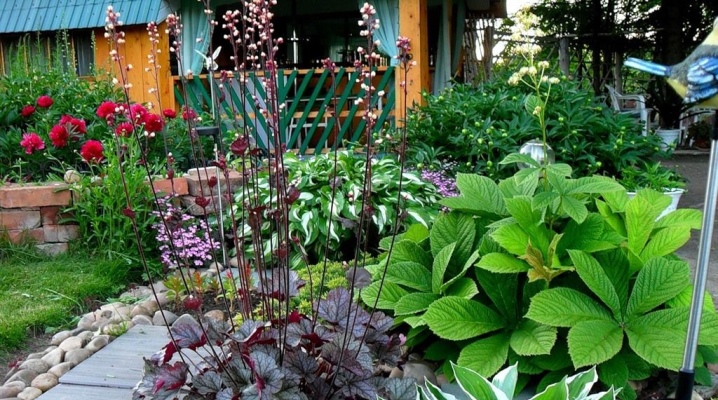
Geichera is a beautiful ornamental plant and is highly regarded by gardeners. Its popularity is due to its ability to change the color of the leaves, which occurs several times per season. This distinguishes it from other decorative species and allows it to be used for bold landscape solutions when decorating recreational areas.

Description
Heuchera (lat. Heuchera) is a perennial herb of the Saxifrage family, widely cultivated in many countries of the world. It owes its name to the German botanist Johann Heinrich von Heicher, who lived in 1677-1746 and described this spectacular species. The native land of the plant is considered to be the mountainous regions of North America, where it is better known as the purple bell or spotted geranium and is widely used in folk medicine.

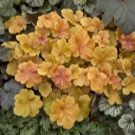




However, heuchera did not always look spectacular; even at the beginning of the 20th century, the plant was a nondescript bushes that did not stand out in anything special among other decorative greenery. The situation changed radically after the work of French specialists - the Lemoine brothers. Their work has resulted in numerous hybrids resulting from the crossing of different types of flowers. A little later, their example was followed by a botanist from England Alan Blum, who for several decades in a row was engaged in the development of new varieties that amaze the imagination with originality and diversity.



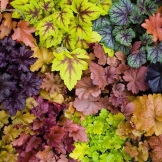
Today, the perennial is considered one of the most spectacular and unusual plants and is able to transform even the most dull landscape beyond recognition. Any flower garden or flower bed on which heuchera is present acquires a unique charm and stands out noticeably against the background of the garden variety. Geuhera is so unpretentious that it grows even in the deserts of Arizona and California and is able to adapt to rocky soils, completely devoid of soil. Outwardly, the plant is a compact herbaceous shrub about 50 cm high.
- There is no central stem as such, but leaves with petioles 30-40 cm long have a root arrangement. Each leaf consists of 5 fused lobules.
- The plant has a taproot system, with a fleshy central root up to 50 cm long, and one bush often has several roots.
- Paniculate inflorescences consist of small flowers of red, white, pink and even green colors. Interestingly, in one variety, they may look rather ordinary-looking, while in the other they simply “burn with fire”.
- The capsule fruits contain several thousand extremely small seeds, which are much smaller in size than poppy seeds (one gram contains up to 20,000 seeds).




Views
According to the modern classification, about 70 species of geychera are currently known, which are subdivided into mountain and forest. The former are a more numerous group, however, the latter have higher decorative properties and are more often used in landscaping. They quickly adapt to garden conditions and grow well in organic-rich soils. Mountain species have denser leathery leaves, a rhizome well adapted to life on stones, and poorly tolerate excess organic matter.In this regard, when growing mountain species, they need to create specific conditions, similar to those that are present in the wild. Below are the most famous species that are most common in garden plots.
- Heuchera cylindrical (Heuchera cilindrica) is a representative of mountain species and grows in the highlands of the Pacific coast of America. This species is considered the largest and is distinguished by large flowers and small leaves. The inflorescences are cylindrical in shape and consist of beige, green, pinkish or coral flowers that look like bells and have short pedicels. A silvery pattern or contrasting venation is clearly visible on the leaves. The plant prefers well-drained soils and light partial shade.


- Heuchera blood red (Heuchera sanguinea Engelm) found in the southern United States and northern Mexico. Despite its subtropical origin, it tolerates winters well and is cultivated in the middle lane. The plant has serrated leaves forming compact rosettes up to 25 cm high. Peduncles grow up to 50 cm and consist of crimson, red or pink bell-shaped flowers, collected in paniculate inflorescences. The flowering period of the species reaches 90 days. Americans are very fond of this flower and call it a red bell.


- Heuchera micrantha is considered the most spectacular species and grows on the Atlantic coast of North America. The outlines of the leaves of the plant resemble the leaves of the Norway maple. Paniculate inflorescences grow up to 60 cm and consist of many pink-cream flowers with orange-red anthers. Flowering begins at the end of May and lasts 2 months.


- American Heuchera (Heuchera americana L.) belongs to the forest species and has beautiful heart-shaped leaves, forming a spectacular rosette, reaching a height of 15-20 cm. The leaf blades are speckled with red veins, located on long petioles and painted underneath in a lilac-brown color. Peduncles reach a height of 60 cm, consist of yellow-green flowers and form paniculate inflorescences. The species has a second name - mountain geranium and is very interesting for breeders. During the season, the plant changes its shade several times, while the most juicy colors can be observed in spring and autumn.


- Heuchera hairy (Heuchera villosa) naturally occurs in the valley of the Mississippi River and is characterized by large beautiful velvety leaves, pubescent peduncles and small nondescript greenish-cream flowers. The species loves humus-rich, moist forest soil and prefers slightly shaded areas.


Varieties and their shades
Geykhera is characterized by a large varietal variety, numbering about 400 hybrids and varieties. The following are the most popular ones.
- Heuchera Cappuccino has coffee-brown leaves, which turn green by the end of the growing season, and their outer side becomes dark purple. The plant has beautiful white-cream flowers and blooms from June to August.


- Geichera Prince It differs in large, strongly corrugated leaves, the outer side of which is purple in color, and the lower one is purple. The flower belongs to the 4th class of frost resistance and can be grown on the territory of our country. The plant is distinguished by its early flowering, which begins in May and ends in early July.


- Geuchera Champagne interesting in that during the growing season it changes the color of the foliage several times. In the spring months, it is pinkish-peach, in the height of summer it is yellow, and in September it is golden. White flowers have dark burgundy cuttings and look very graceful. The plant also belongs to the 4th class of winter hardiness and is able to withstand 35-degree frosts.


- Hybrid Mars grows up to only 20 cm and is distinguished by beautiful light green leaves with a silvery-red pattern and white flowers. Flowering lasts about two months. The plant belongs to the category of frost-resistant and can be grown in Russia.
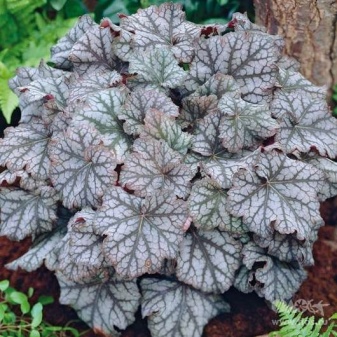

- Geichera Lime Rickey changes its color during the season and is highly decorative. In spring, its leaves are pale green in color, by July they become brightly lemon, and by September they acquire a rich green color. Flowering begins at the end of May and lasts 2 months. White flowers with notes of ivory are in perfect harmony with the leaves and look very organic. The flower can be a decoration of any flower bed and is able to grow both in the sun and in partial shade.


- Geykhera hybrid "Amethyst Mist" (Amethyst Myst) very popular with gardeners. The plant reaches a height of 25-30 cm, it is unpretentious in care, however, it is afraid of strong waterlogging. The leaf plates have a lilac-burgundy color and are decorated with large silvery spots. Paniculate inflorescences consist of small cream-colored flowers. In general, the variety is frost-resistant, however, during snowless winters, it needs additional root cover.


- Geuchera "Paprika" differs in large wavy leaves that change color as they grow. In the spring months, they have a bright salmon color, and in the summer they acquire a bright coral and even cherry color. White venation gives the leaves a great piquancy, making them noticeable and elegant. The flowers of the plant are white, the flowering period is May-June.


- Geuchera "Tiramisu" is a low herbaceous shrub 25 cm high. The color of the foliage changes three times per season. In the spring, the leaves have a red-brick color, in the summer they turn smoky-silver, and by autumn they again become brick-red, but already with a yellow tint. Flowering begins in July and ends in September.


- Geicher "Marvelous Marble" (Marvelous Marble) Is a herbaceous perennial, reaching 25 cm in height and blooming in the first half of summer. The variety has good frost resistance, but does not tolerate excess moisture. Therefore, it is not recommended to plant it near water bodies and water it often. The plant blooms with red flowers and is great for landscaping flower beds and rockeries.


- Heuchera "Penelope" is a popular cultivar with pink-orange leaves and white flowers. Flowering falls in June, winter hardiness class is 4, the preferred landing site is the sun or partial shade. The plant is widely used to decorate borders, flower beds and mixborders and looks good both as a single planting and as a group.


How is it different from Heykherella?
Some novice gardeners often confuse Heuchera with its hybrid - Heycherella, obtained by crossing the mothers of Tiarella and Heuchera. The hybrid was developed in France in 1912 by the works of the botanist Emile Lemoine, who crossed sterile heuchera with heart-leaved tiarella (Tiarella cordifolia) received pink-flowered heycherella. A little later, another hybrid was discovered, obtained from the crossing of Heuchera with Tiarella Veri, and was named White-flowered Heycherella. The difference between Heucherella and Heuchera is that the hybrid is much more compact than the mothers and is able to retain color on the bushes for a long time. On average, Heucherella stays in bloom for 3 months, while most Heucherells last only 2 months.


Choosing a place
When choosing a place for a geychera, it is necessary to take into account the varietal and species belonging of a particular plant. If you cannot find information about the variety, then you can use one general rule: specimens with silver or yellow leaves need sunlight and will suffer from a lack of it, while bushes with green and raspberry leaves, on the contrary, like shading. But even sun-loving varieties are not recommended to be planted under the scorching sun... The best option would be to plant them near tall plants that will create shade at midday.

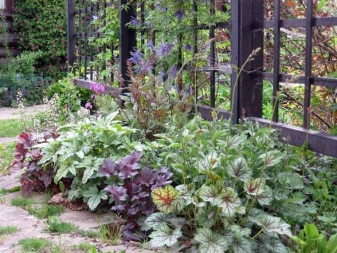
In addition to the insolation regime, it is necessary to take into account the strength of the wind, and, if possible, protect young bushes from drafts. In this regard, it is recommended to cover the seedlings with a protective shield at least from the north side. It is also necessary to pay attention to the presence of groundwater and, if the aquifers are located close, choose a drier area for the plant. Geykhera grows poorly in humid lowlands and does not like wetlands.


The next important criterion is the type of soil. The plant prefers fertile soil with an acidity of 5-6 pH, and mountain species are able to grow in rocky terrain. If the soil is too acidic, it is recommended to neutralize it with ash or dolomite flour. Good drainage is essential for the proper growth and development of Heuchera. For its arrangement, you can use broken brick, large rubble or river pebbles. If it is not possible to build a drainage system, then you can mix the sand with a small amount of expanded clay and sprinkle the roots with them when planting.

Landing rules
The best time to plant Heuchera is mid-spring. Seedlings are purchased in the store or obtained independently, using a vegetative propagation method of the bush. In both cases, the landing is carried out according to the general algorithm, the main points of which are discussed below.
- Before proceeding with planting a seedling, it is necessary to examine its roots, and if sick, rotten or damaged processes are found, immediately remove them, and sprinkle the sections with charcoal.
- It is recommended to plant in a checkerboard pattern, maintaining a distance of 50-60 cm between adjacent bushes.
- The size of the holes depends on the branching of the root system and averages 30x30 cm.
- At the bottom of the pit, drainage must be laid and sprinkled with a layer of sand 5 cm thick. Garden soil is poured on top, adding nitroammofosk to it at the rate of 15 g for each bush. If the soil is severely depleted or has low fertility, it is recommended to mix it with compost or humus. However, adding organic matter, you should study the characteristics of the variety, since not all plants tolerate it in high concentration.
- A seedling is placed in the middle of the pit, the root processes are carefully straightened, covered with a substrate and tamped.
- Each bush is watered with 3-5 liters of water and a shading screen is erected for a couple of days, which is then removed.




If the agricultural technique is not violated, and everything is done correctly, rooting occurs in 40-45 days.
How to transplant?
If soon after planting it became necessary to transplant a young plant, then this can be done not earlier than the next season. This is due to the fact that the root system of young Heucheras is rather delicate; during transplantation, there is a risk of damaging it and ruining the bush. Plants older than two years of age tolerate transplantation well, however, special care must be taken when moving them to a new place. Previously, the bush is well spilled and waited until the water is absorbed. Then they carefully dig it out of the ground, trying to preserve the earthy lump as much as possible, and move it to a new place. Then the roots are covered with earth and carefully tamped.


Care
Heuchera is an unpretentious plant and needs minimal maintenance.

Light and temperature conditions
Adult Heuchera prefer shade and partial shade, while young plants need more sun. Seedlings growing in shaded areas develop slowly and grow poorly. As for the temperature, then Heuchera feels great at 15-35 degrees and quickly adapts to the proposed conditions.


Watering
In the heat, heuchera is watered 2-3 times a week, from time to time loosening the trunk circle. The plant tolerates light drought much better than excessive moisture. Watering is performed early in the morning or late in the evening, trying to prevent water from getting on the leaves of the plant. To retain moisture in the root zone, the bushes are mulched with sawdust or needles.


Fertilizer
In the first year after planting, Heuchera does not need fertilization. Further, fertilizing is applied annually three times a season. In early spring, before the appearance of greenery, nitrogen-containing preparations are used, in the summer - potassium-phosphorus fertilizers, and in the fall the flower can be fed with a mullein solution or other organic composition. In addition, a couple of times a season the bushes are powdered with ash.


Reproduction
Heuchera is propagated in three ways: by cuttings, dividing the bush and seeds.
- The division of the bush is performed as follows: choose a healthy bush 3-4 years old, dig it out of the ground and divide the root into several parts with a sharp disinfected knife. The cut points are sprinkled with crushed coal, after which too long roots are cut off, new plants are planted in holes and watered.

- The grafting procedure is as follows: several cuttings 4-6 cm long are cut from a healthy bush as close to the ground as possible. The cut is treated with "Kornevin", the lower leaves are removed and the cuttings are planted in a substrate of peat and sand. Cover the top with a glass jar and put it in the shade. The stalk is periodically ventilated and sprayed, preventing the substrate from drying out. After the appearance of new leaves, the jar is removed and the plant is transferred to a general care regimen.

- The seed breeding method looks like this: at the end of March, fresh seeds collected less than 6 months ago are taken and sown in a box 5 cm high. Loose soil is used as a substrate, consisting of equal parts of sand, peat and garden soil. The soil is preliminarily spilled with boiling water, cooled and dried. Then heuchera seeds are mixed with sand and sown. From above, the box is covered with foil or glass, placed on the south window.

The optimum temperature is considered to be 18-20 degrees. Every day, the planting is aired for at least 15 minutes and sprayed as the soil dries. After 20 days, the seeds sprout, after which the film is lifted or small holes are made in it. After 2-3 leaves appear on the sprouts, the seedlings dive into separate containers. At the end of May, young plants are planted in open ground in a sunny place and transferred to general care.

Diseases and pests
Heucheras rarely get sick. However, in the case of excess moisture, they can be affected by powdery mildew or gray rot, which respond well to fungicide treatment in combination with transplanting to a drier place. When spotting or rust appears, a solution of Bordeaux liquid helps, and you can eradicate nematodes, caterpillars and snails mechanically or with the help of insecticides.

What plants in the flowerbed is combined with?
Geykhera looks great with such plants: astilbe, bergenia, primrose, brunner and all kinds of ornamental cereals. The plant is often used in mixborders and is in perfect harmony with dwarf and other small-leaved shrubs. The culture looks good next to a rose, hosta, fern, lily, iris, tulip and early-flowering bulbous species.
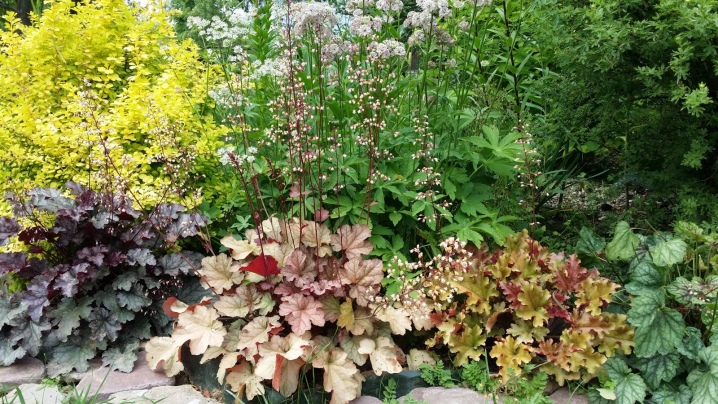
Use in landscape design
Due to a wide variety of varieties and high decorative characteristics, heuchera occupies one of the leading positions in the choice of plants for decorating borders, flower beds and flower beds, perhaps second only to the hosta.
- Heuchera as one of the central design elements of the rock garden.
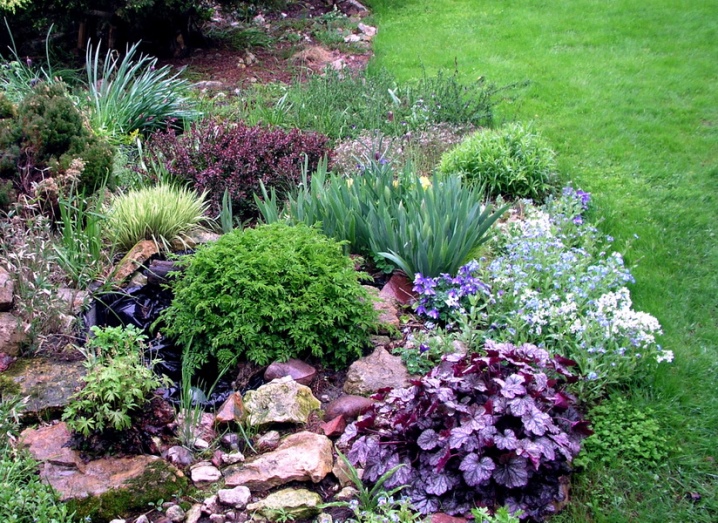
- A plant in a container will be a great decoration for a gazebo or yard.

- Geichera is ideal for framing artificial reservoirs.

- The flower looks great in single-species compositions.

- Heuchera in the company of small-leaved shrubs looks very natural.

For information on how to properly plant a Heuchera, see the next video.







































































































Wonderful, helpful article about geykher! I love all flowers, but I especially like any kind of Heuchera. Thanks for the selection of varieties!
The comment was sent successfully.